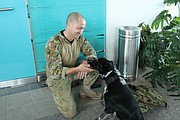Fighting and learning together
MOSES LAKE — The battle for the Grant County International Airport began at a little before midnight Wednesday.
As giant jet-powered transport planes flew low, no more than 1,500 feet off the ground, they dropped giant pallets of equipment and vehicles out the back that would thud as they hit the airport’s darkness-enshrouded main runway.
It was hard to see the parachutes unfurl and billow in the pitch darkness, but this was only the beginning.
Within an hour, more than 500 soldiers of the 82nd Airborne Division were down on the ground, creeping through the sagebrush and the darkness. You could hear them long before you could see them.
But you still couldn’t see them. Not until they were almost upon you.
Facing them were at least 100 American soldiers dressed as terrorists holding the main terminal. They waited in the silence, guns at the ready, having set booby traps and turned the inside of the terminal building into something of a maze, unsure where or how the advancing paratroopers would attack.
Only that they would.
This was the ground component of a military exercise called Mobility Guardian, a multinational exercise comprising the air transport arms of 10 nations (with another 14 militaries observing). For the next week, U.S. and allied troops will be “running” Grant County International Airport and setting up the kind of supply and logistics operation needed in war or a major natural disaster.
But first, troops had to take the terminal.
The paratroopers assaulted from the east about 2 a.m., crossing the wide expanse of runway almost unseen in the darkness. The fire — all blank rounds — was fierce and short, with military umpires walking around and pronouncing the occasional terrorist or soldier dead.
“They got you with a grenade!” one umpire said.
A squad of paratroopers slowly crept around the north side of the terminal building, looking for an unlocked door to get in. Another group of soldiers attacked from the main entrance, distracting the defenders.
“I found a door,” one soldier said. “It’s clear!”
Pop! Pop! Pop!
“The fact that there’s firing means it’s not clear!” an annoyed voice responded.
By 2:30 a.m., it was all over. The paratroopers were assisting the “wounded,” taking prisoners, and making sure the bodies of the “dead” were not booby-trapped. The insides of the terminal were a mess — furniture overturned, brass shell casings everywhere, and gear piled up in nearly every conceivable corner.
By midmorning, you couldn’t tell there’d ever been a major firefight here. The terminal was clean and neat and ready for business.
And there wasn’t an American soldier to be seen anywhere.
“Last night was good fun,” said Flight Sgt. Keith Voysey of the UK’s Royal Air Force (RAF). “I didn’t wake up once during the tidying up.”
Voysey, a 25-year veteran of the RAF, said the goal of this exercise is to learn and practice working together. The RAF Regiment — based in Oxfordshire, though it includes soldiers from the Royal Australian and Royal New Zealand Air Forces — finished securing the terminal in the wee hours of the morning, and is setting up a secure perimeter around the airport that its soldiers will man over the next week.
“We’re practicing procedures and processes, how each nation’s tactics, techniques and procedures will work with each other,” Voysey said. “That’s about it, really.”
Over the next week, the soldiers of the RAF Regiment will deal with external threats to the base, such as insurgent activity.
“We expect to have unconventional threats,” said RAAF Flight Lieutenant Zac Smit. “Our job is to keep the bad guys away.”
Corporal Mark Douglas, a military police dog handler in the RAAF, sat on the floor with Banjo, a border collie trained to detect bombs, after a long morning. Part of securing the terminal meant looking for explosives.
“I’ve been a dog handler for 10 years, and in the military for eight, but this is Banjo’s first tour,” Douglas said. “This was a new experience for him, flying on an airplane. And he’s easily distracted by the food right now.”
A group from the Colombian Air Force sat in another part of the terminal. While soldiers from the Colombian special forces were helping to secure the perimeter for the exercise, these airmen were part of a medical team primed and ready to evacuate anyone seriously injured.
“We share our experiences with other countries,” said Major Luis Carlos Perez, a 17-year veteran and pilot in the Colombian Air Force, as he showed off his brand new Spanish-built C-295 transport.
“We can carry 8 tons of cargo or 71 paratroops,” he said. “We also have two litters for the wounded.”
On one of those stretchers slept an American Air Force officer, oblivious to it all.
Charles H. Featherstone can be reached via email at countygvt@columbiabasinherald.com.





